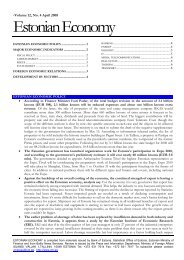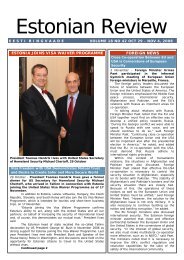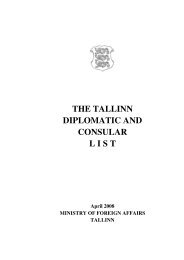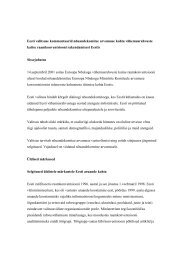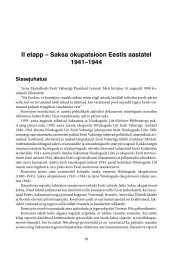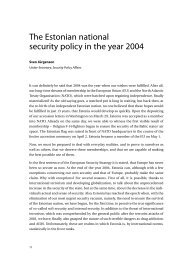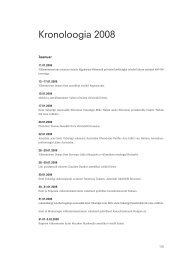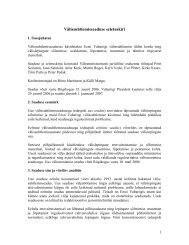Opportunities for Cooperation between Estonia and ... - Valitsus
Opportunities for Cooperation between Estonia and ... - Valitsus
Opportunities for Cooperation between Estonia and ... - Valitsus
Create successful ePaper yourself
Turn your PDF publications into a flip-book with our unique Google optimized e-Paper software.
On continental Europe, rail transportation is growing in importance. Rail Baltica<br />
is a plan to provide a railway link from Tallinn to central Europe. Even though<br />
the plan is still in its infancy, all the potential it offers should be explored. A train<br />
ferry service across the Gulf of Finl<strong>and</strong> would be needed simply <strong>for</strong> transporting<br />
goods, particularly timber, <strong>between</strong> <strong>Estonia</strong> <strong>and</strong> Finl<strong>and</strong>. At the same time, it<br />
would give Finl<strong>and</strong> access to the anticipated Rail Baltica connection.<br />
Although Helsinki <strong>and</strong> Tallinn are the most important growth centres in the<br />
respective countries, no globally significant growth centres are expected to<br />
emerge in the Nordic or Baltic states in the <strong>for</strong>eseeable future. Consequently, a<br />
proposed subsea railway tunnel <strong>between</strong> Helsinki <strong>and</strong> Tallinn will not have any<br />
global impact on the flow of goods. As it is, most of the regionally significant<br />
goods transports are already h<strong>and</strong>led by sea.<br />
In January 2007, the European Commission issued a communication<br />
concerning closer integration of EU transport system with the neighbouring<br />
countries <strong>and</strong> guidelines <strong>for</strong> transport in Europe <strong>and</strong> the neighbouring regions.<br />
In the communication, the Commission proposes the development of five main<br />
transport axes <strong>for</strong> international trade. Of these, the most important to <strong>Estonia</strong><br />
<strong>and</strong> Finl<strong>and</strong> is the Northern Axis designed to link the northernmost parts of<br />
the EU to Norway in the north <strong>and</strong> to Belarus <strong>and</strong> Russia in the east. At the<br />
same time, the Northern Axis would guarantee the EU’s access to the Barents<br />
region.<br />
Even if this scenario were to materialize, a railway tunnel <strong>between</strong> Helsinki <strong>and</strong><br />
Tallinn would, at best, only offer an alternative to current shipping services<br />
without creating any really new traffic route either within the EU or <strong>between</strong><br />
the EU <strong>and</strong> other countries. Once the railway tunnel was in service, it would<br />
mostly be of question of how the volume of transports would be divided<br />
<strong>between</strong> the tunnel operator <strong>and</strong> the shipping lines (as in the case of the<br />
Euro Tunnel <strong>between</strong> Great Britain <strong>and</strong> France or the Öresund Bridge <strong>between</strong><br />
Malmö <strong>and</strong> Copenhagen).<br />
A Helsinki-Tallinn railway tunnel could increase transports <strong>between</strong> the Black<br />
Sea, the Mediterranean <strong>and</strong> the Baltic Sea ports, especially when goods are<br />
carried from the Ukraine, Romania, Bulgaria, Turkey <strong>and</strong> countries in South<br />
Caucasus <strong>and</strong> central Asia <strong>and</strong> vice versa. Additionally, the railway tunnel<br />
would offer a direct route to Finl<strong>and</strong> <strong>for</strong> goods shipped via the Suez Canal<br />
from Asia <strong>and</strong> the Pacific (Japan, Korea, China <strong>and</strong> India). From the point<br />
of view of Russia or other CIS countries, the railway tunnel would hardly be<br />
competitive.<br />
42





